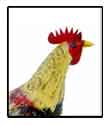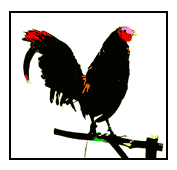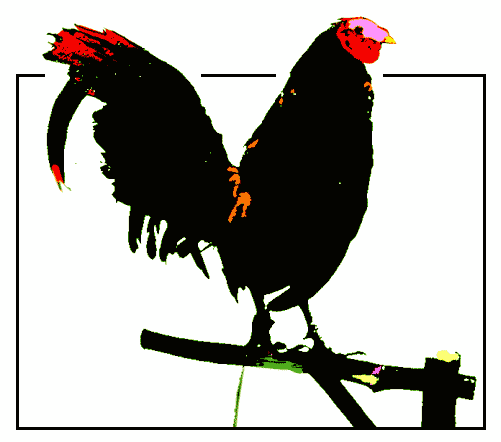
It is the brutal and bloody "sport" of two gamecocks pitted
against each other, predicated on one killing the other. Literally,
a fight to the finish. To the unaccustomed, a gruesome and disgusting
sight. But to the passionately addicted, testosterone-fueled and adrenaline-raging
sabong aficionados, it is a fierce, bloody, and slashingly entertaining
fight-to-the-death that repeats itself 20 to 30 times in a single day
of cockfighting.
Behind
this gruesome sport is an all consuming male-oriented pastime
fueled by a passion that transcends into a quasi-religion—a common man's
grail.
THE
LANGUAGE
OF BETTING ODDS |
|
Parehas
Even odds |
Lo dies
Logro diez
100 wins 125
200 wins 250
400 wins 500 |
Walo-anim
300 wins 400
600 wins 800 |
Onse
400 wins 550
800 wins 1100 |
Tres
1000 wins 1500 |
Sampu-anim
600 wins 1000 |
Doblado
1000 wins 2000 |
| |
|
|
It has been called a "national
sport" – a designation that easily draws divisive argument.
(I take the side that basketball is the national sport.) But, it is a "national pastime" – a sphere of activity
where class lines blur, a game enjoyed with equal fervor by both the
rich and the masa. Parity, however, is more imagined than real.
The moneyed aficionados are usually involved with expensive brood cocks
of pedigree lineage bred for "fastest kill" and trained for
big money derby events, with a variety of breed-names as descriptive
as: lemon, radio, white kelso, Madigan Grey, McClean, roundhead, claret,
or sweater. In contrast, much of the rural-provincial folk are involved
with training and conditioning their low-pedigreed mestizo
cocks, usually for hack fights. For the rich, it is the
"sport of kings" – of nerve and verve, macho and ego,
and the tens-of-thousands of pesos or even millions won or lost with
a shrug. And for the masa, a sport of dreamers, pitting their
lowly-rural-bred against a burgis cock, betting their meager wages and
rainy-day savings, high on a belief that on any day, with the luck of
a parry-dodge-and-slash. . . and a prayer. . . his game cock can win.
In seeming parity, there
are months of conditioning and training, sparring days and rest days, countless diet regimens, energy boosters and supplements -- tonics, B-complex and B12 shots,
stimulants, multivitamins, and even prefight doses of testosterone – endless variations that always buy the rich
an edge. It is an intense regimen of training dedicated to instill in
the cock the skills for survival and the art of killing, for which they
are rewarded with excessive doses of TLC – preened, stroked, massaged
and shampooed. It is not an exaggeration to say that some men give more
loving attention to his fighting cocks than to the wife and kids.
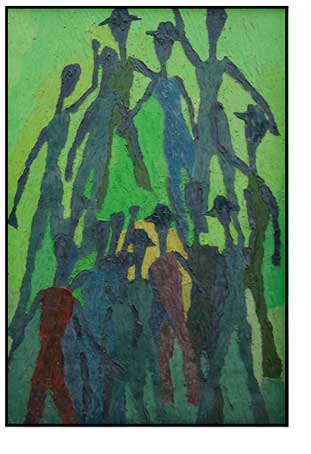 This pastime is
a multi-billion-dollar industry in the Philippines. It is a lucrative sport with a commerce that caters to a diverse class of afficionados, from the fanatical moneyed devotees to the boondock dreamers and masa addicts. The commerce provides for a whole array of needs, choices and decisions way before the cocks make it to the arena: the source of gladiator cocks, imported
hi-breed eggs, bloodlines and crosses, genes and progeny testing, pedigreed breeding farms, breeding, linebreeding and crossbreeding, training schools specializing
in fast kills, supplements and pharmaceuticals, specialized cock-doctors. And to boot, a cable television program to provide bloody entertainment and to sell cock goodies from. This pastime is
a multi-billion-dollar industry in the Philippines. It is a lucrative sport with a commerce that caters to a diverse class of afficionados, from the fanatical moneyed devotees to the boondock dreamers and masa addicts. The commerce provides for a whole array of needs, choices and decisions way before the cocks make it to the arena: the source of gladiator cocks, imported
hi-breed eggs, bloodlines and crosses, genes and progeny testing, pedigreed breeding farms, breeding, linebreeding and crossbreeding, training schools specializing
in fast kills, supplements and pharmaceuticals, specialized cock-doctors. And to boot, a cable television program to provide bloody entertainment and to sell cock goodies from.
At the spectrum's other end, there are are the rural afficionados who make up the majority of cockfighting devotees, low on science and high on hopes, picking from a flock-mated brood, often of concocted or imagined pedigree, guided by cock physiognomy and the accumulated oral hand-me-down bible of rural sabong.
A betting heritage sport
Brutal, bloody, and entertaining—all that, but it's also a betting sport. Betting is a sine qua non of sabong. In fact, without betting sabong will be transformed into an unrecognizable namby-pamby sport. Betting discharges the adrenaline and stokes the din and theater of the kristos. With the Cockfighting Law of 1974, President Ferdinand E. Marcos, stamped his imprimatur on sabong with Presidential Decree No. 499, essentially designating it as a "vehicle for the preservation and perpetuation of native Filipino heritage and thereby enhance our national identity." The cock-a-hoop endorsement provided legal status to kristos and the culture of cockfight betting.
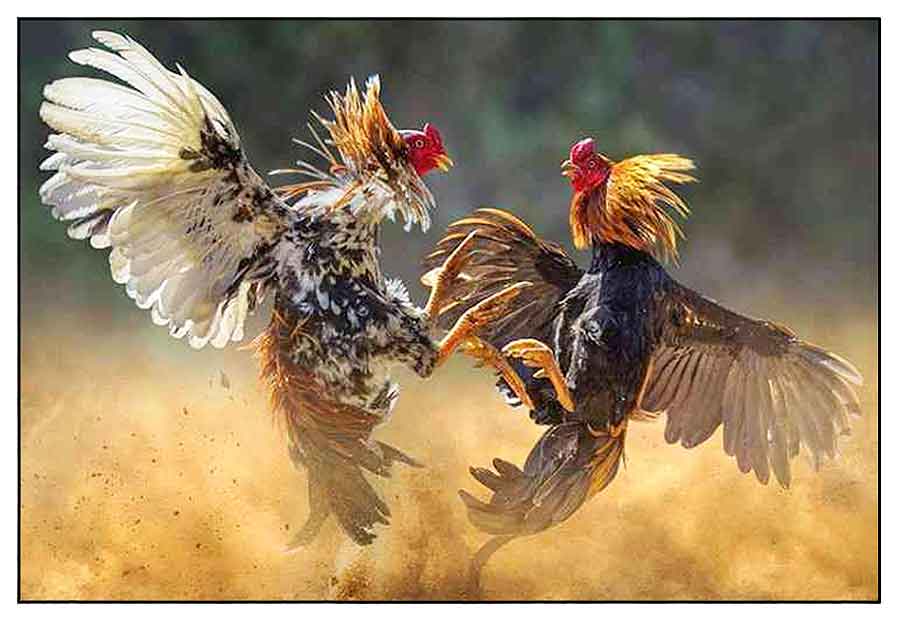
Superstitions,
while providing comic color to cockfighting, are taken seriously by
many rural sabong devotees.
(1) The arrival of a female visitor on the day of the
cockfight is inauspicious.
(2) Do not sweep the floor of the house on sabong day.
(3) Avoid cockfighting on Fridays.
(4) Avoid going to the cockfight with a hole in one of the pants' pockets.
(5) Don't look back when walking to the cockpit arena.
(6) Bet on the "mayahin" and white cocks on days with moonlit
nights.
(7) It is an unlucky day if one runs into a funeral procession on the
way to the cockfight.
(8) Shaving is avoided on sabong day for fear it might cause the game
cock's blade to break.
(9) Avoid having sex the night before.
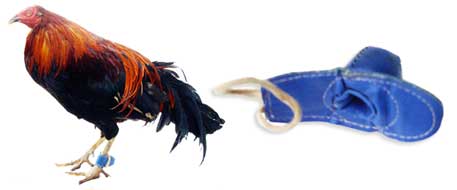 |
Cock
with training gloves |
| |
The
Derby
and the Hack Fight
Hack fights are literal to the root word: Hack, to cut, chop, hew, slash
or gash. These are the generic ulutan-paired cockfights, 20 to 30 in
an afternoon of cockfighting. This is when the masa can mix blades with
the deep-pockets and burgis.
The derby, once referred
to as the "pintakasi," is the cockfighting event for the serious
aficionado and deep-pockets. The cocks are paired according to weight.
Each team enters with a team-name and a fixed "pot money"
amount (ex: P10,000 for each of 10 teams makes a 100,000 total pot)
that becomes the prize-money for the team with the most wins. A 3-cock
derby may last deep into the night or past the midnight hours; a 7-
or 9-cock derby may last for days.
Cockfights
for the Dearly Departed
Tupadahan para sa Patay
In the rural areas, the dead is occasionally an opportunity for cockfighting.
To help defray funeral expenses, a complimentary permit is obtained
from the municipal government to allow cockfighting during the 3-5 days
duration of the wake. Usually, 10 percent of the winnings (palisada)
from each cockfight (soltada)
is contributed to the funerary coffers. The come-one-come-all invitation
easily spreads through the rural grapevine, and die-hard sabuñgeros
come, many not to grieve the dead but for the delight of the
game.
Carambola is the occasional sabong sideshow - an entertainingly wild
and zany labo-labo event that pits six to sixteen or more cocks at one
time, simultaneously slashing-and-parrying until one cock remains standing.
The winning owner claims all the dead cocks plus the prize pot money.
Game
Day
Sabong 101
Behind the scenes, on a sabong day, there is a busy activity of the
game cocks being paired (ulutan),
owners intensely wary of the many dishonest, deceitful or accidental
ways an edge may be gained by the opposing cock. Surreptitiously, by
the swift and expert motion of a hand, a rib can be cracked, a wing
disabled or a leg sprained. A poisoned grain or niblet of food could
be flicked to the opposing cock's pecking space. Searching for an opponent,
both sides look for parity or an imagined edge, guided by experience
and intuition, carefully doing a thorough measure of his cock's chances
through a visual of the opposing cock's breeding, weight, stance, wing
span, head size, beak length, plumage quality, and gameness. When the
acceptable pairing is found and agreed upon, the "tari"
blade is commissioned for attachment, usually to the left leg, and payment
to be due only if the cock wins. Even at this stage, an advantage may
be lost, unintentional or by collusion, with the 'blade man's"
slight but critical maladjustment of the blade. Stories are told of
blades being impregnated with "poison" that may render the
opposing cock ineffective and compromised.
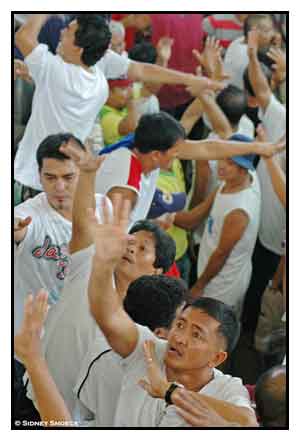 The Kristos The Kristos
As soon the casador announces "Larga na!" the kristos take over. The arena erupts into a deafening din of kristos calling out and taking in bets from the spectators, their arms splayed Christ-like, flailing wildly in the air, beckoning bets, their hands and fingers in a frenzy of motions and signals.
It is a fascinating display of memory, as some kristos, with their own system of mnemonics, are known to take in as much as 8 to 10 or more bets.
For many kristos, the trade is their main livelihood. While they expect a 10% service tip on winning bets - which they don't always get - they make nothing on losing bets. But that is just part of their commerce. On the sidelines, there is a fast and furious buying-and-selling of bets. Unbeknownst to bettors, many of the kristos often get better odds on alleged "even" wagers, pocketing the difference on winning bets. This can also be done in collusion with another kristo, the returns divvied up at the end of the day.
|
Hand Signs 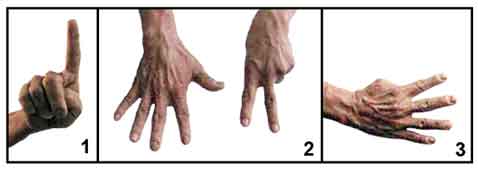 Because of distance and the deafening noise, kristos rely on hand signs to communicate their bets with other kristos. Knowing the arithmetic language of fingers facilitates communication with your kristo and adds a fascinating facet to the sabong experience. (1) Upward fingers: In small arenas, especially in the rural and boondock hack fights where small bets are not uncommon, each finger signals 10 pesos; five fingers, 50 pesos. In big cockpits or derby events, an upward finger could mean 10,000 or 100,000 pesos. (2) Downward fingers: Each finger is equivalent to a 1000-peso bet; 7 fingers, 7,000 pesos. Caution is given in pointing the fingers downward twice, as this will be interpreted as a 14,000-peso bet. (3) Sideward fingers: Each sideward finger is equivalent to 100 pesos. In the figure, the four fingers denote 400 pesos. Because of distance and the deafening noise, kristos rely on hand signs to communicate their bets with other kristos. Knowing the arithmetic language of fingers facilitates communication with your kristo and adds a fascinating facet to the sabong experience. (1) Upward fingers: In small arenas, especially in the rural and boondock hack fights where small bets are not uncommon, each finger signals 10 pesos; five fingers, 50 pesos. In big cockpits or derby events, an upward finger could mean 10,000 or 100,000 pesos. (2) Downward fingers: Each finger is equivalent to a 1000-peso bet; 7 fingers, 7,000 pesos. Caution is given in pointing the fingers downward twice, as this will be interpreted as a 14,000-peso bet. (3) Sideward fingers: Each sideward finger is equivalent to 100 pesos. In the figure, the four fingers denote 400 pesos.
|
In the cockpit (ruweda),
the owners and cocks are assigned sides: MERON
– for the one with the larger pot-money bet or favored
game cock, the sign lit-up denoting llamado
or favored status, and WALA, under an unlit
sign, signifying
dejado or long shot. The cocks are allowed
a short time and distance to walk, for the betting spectators to observe
stance, strut and gameness. Then the "casador"
announces the opposing bets and when needed solicits amounts from the
ringside bettors to equalize the bets. Then he shouts: Larga na! And
spectator betting starts. The "kristos,"
betting managers sacrilegiously named for their Christ-like crucified
stance, arms stretched out beckoning the spectators, taking bets, their
hands and fingers wild in the sign language of bets and odds. The noise
builds up to a din of deafening decibels. As the betting goes on, each
cock is also allowed to peck on the other's head (kulitan),
each to anger the other and maintain a level of aggressiveness.
Then
the protective sheaths or wrapping on the tari blades are removed
and wiped clean with alcohol-impregnated cotton or cloth to remove any
possible poison. Then the cocks are released. Sometimes, they linger,
circle, peck on the ground, watchful, waiting, and measuring their opponent.
More often, they charged into each other, winging up into the air to
a determined confrontation of death. Then, in a blur and flurry of beating
wings, parrying moves, and the midair exchanges of lethal slashes of
blade. Sometimes, it goes on for a minute or longer. The din crescendos
into deafening decibels. Every deadly slash, every graceful parry elicits
a cheer, moan, grunt or groan. Sometimes, victory is claimed on the
initial parry and slash, the deed of killing is accomplished in a mere
five seconds, as one cock lies, trembling and shaking to his death.
Then, as suddenly, the noise deflates into a buzz. The "sentensyador"
(referee) picks up the cocks. The victorious cock pecks twice on the
vanquished, and when the pecks are not returned, one cock is raised
victorious.
Rarely, both the
cocks die, and a "tabla" (tie)
is called. Another uncommon occurrence is when both are disabled by
wounds, neither one able to inflict a lethal slash, and after nine minutes,
a tie or tabla is called.
To
the owners, the loss is pecuniary, unemotional – there is no bonding
between cock and owner. These are, after all, mere sacrificial animals,
whose main purpose is to win, and to win as many before the inevitable
death. An occasional cock may be saved from the eventual death, retired
as "ganador" to sire a bloodline of genetic killers. To the
rich, death is accepted with a shrug, and "on to the next fight." To
the masa, it is the all too familiar exercise of pondering the lost wages,
the "so close" and "what ifs," at the same time
hoping his other gamecock will turn his fortunes around. The vanquished
cock is claimed by the winning side, referred to as "sambot,"
destined to a pot of celebratory chicken concoction, usually tinola,
to serve as side dish to accompany the alcohol fueled recalling of the
day's cockpit adventure and the inevitable re-telling of favorite sabong stories.
Sabong in the history books
Cockfighting goe back to classical times. There is general agreement it originated from Southeast Asia, spreading to Persia, Greece, England, eventually migrating to New World colonies; then as today, enjoyed by both noble and commoner, the rich and the poor, the burgis and the masa.
In the Philippines it dates back to 6000 years ago. In Spanish colonial time, cockfighting was legal, licensing adding to the Spanish coffers. Even then, it was a favorite pastime. Sundays, Festive holidays, and Thursdays (Manila from 1861) were cockfighting days.
In Jose Rizal's Noli Me Tangere, a whole chapter, Chapter 46: The Cockpit, is dedicated to cockfighting, so descriptive of the ambiesnce, noise, and energy in the provincial ruedas of today.
To keep holy the afternoon of the Sabbath one generally goes to the cockpit in the Philippines, just as to the bullfights in Spain. Cockfighting, a passion introduced into the country and exploited for the century past, is one of the vices of the people, more wildly spread than opium-smoking among the Chinese. There the poor man goes to risk all that he has, desirous of getting rich without work. There the rich goes to amuse himself, using money that remains to him from his feasts and his masses of thanksgiving. . . (a worthwhile read. . . Charter 46: The Cockpit)
Sabong is one incredible window to the Filipino culture. And if the
intrepid traveler should have the stomach to venture into one, rather
than the sanitized ambience of the big urban-suburban venues for the
rich and burgis, go to a rural cockpit, and be absorbed by the noise,
by the people, by the thrilla-in-the-ruweda, by this slice of fringe
Filipiniana.
|





